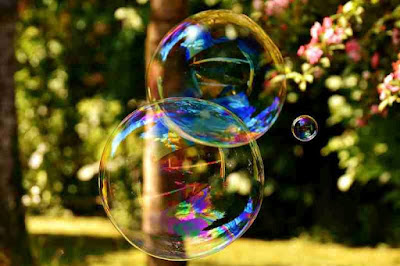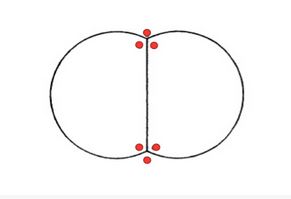 |
Photo via goodfreephotos.com
|
Kids love soap bubbles. So do adults. What’s not to love?
They’re pretty colours, they float and you can pop them. Couldn’t be simpler. Until
you get into the science of soap bubbles. There’s a lot of math, physics and
chemistry in them.
What are they made of? Good enough to eat?
If you look up recipes to make your own bubble liquid, you’ll
find instructions to mix water with dishwashing liquid and glycerine. Glycerine
is an edible sweetener which dissolves in the water. Bubbles are a sandwich: a
thin layer of water between two layers of soap molecules. The soap molecules have
a hydrophilic (water-loving) side and hydrophobic (water-hating) side. The
molecules align themselves with the hydrophilic side attached to the water. The
soap decreases the surface tension of the water, allowing it to stretch into a very
thin sheet. The bubbles usually pop after a few seconds. That’s because the
water evaporates out of the sandwich. The dissolved glycerine slows down the
evaporation process, making the bubbles last a little longer.
Touching the bubbles with anything dry will cause them to
pop immediately. But if you catch them with, or allow them to land on something
wet, they’ll last longer.
Colours
More fun physics here. The colours are created because of
thin film interference (like the colours in an oil slick on the surface of water).
Some light waves (B in the diagram below) are reflected off the outside surface
of the bubble; some (A below) go through the water and then are reflected off
the inside surface.
The reflected waves A and B could be in the same phase and
reinforce each other, as in diagram 1. In this case C (the reflected A and B waves) is stronger than either A or B.
Or, as in diagram 2, the reflected waves could be out of phase with each other.
They essentially cancel each other out and the combined C wave is very weak.
Whether the waves reinforce or destroy each other depends on
the exact thickness of the film and the wave length (colour) of the waves.
 | |
| Diagram 1: Waves reinforce each other |
 | |
| Diagram 2: Waves interfere and destroy each other
Jhbdel [CC BY-SA 3.0], via Wikimedia Commons
|
Shapes
A single bubble will form as a perfect sphere. A sphere is
the shape that has the smallest surface area to enclose a given volume of air. Surface
tension everywhere on the bubble will be the same force in all directions. But
things get more interesting and complicated when you have multiple bubbles
touching. With two bubbles of the same size you get
With three bubbles of the same size you get
In both cases the surfaces meet at an angle of 120°.
Math
This is unexpectedly complicated. In 1760 the legendary
mathematician Jean-Louis Lagrange posed the problem of finding the minimal
surface area to enclose a given boundary. The Belgian physicist Joseph Plateau
experimented with soap bubbles in the mid-1800’s, formulated some laws and the
general problem has been known as Plateau’s Problem.
Work has continued on more and more general solutions to the
problem. It’s hard enough that Jesse Douglas earned a Field’s Medal (the Math “Nobel
Prize”) in 1936 for his work on the problem. More recently, “in 2015 Jenny
Harrison and Harrison Pugh used cohomology to define spanning sets and
Hausdorff measure weighted by a bounded Lipschitz function to define area, and
solved the problem in this setting. Their paper is currently under review”.
(Full disclosure: I have no idea what this math is. But it’s impressive so I just
copied and pasted).
Neat Trivia
Joseph Plateau is also known for being the first to
demonstrate that when you see multiple successive pictures with small differences,
it creates the illusion of movement. In other words, he invented the idea of
movies!
Jenny Harrison completed her PhD in England on a prestigious
Marshall scholarship. She did post-doctoral work at Princeton’s Institute for
Advanced Study (that’s where Einstein, von Neuman and Godel worked) and then
taught at Oxford University for three years. Then, after five years as an
associate prof at University of California – Berkeley, she was repeatedly
denied tenure. She eventually filed a lawsuit based on gender discrimination.
After four year years, a settlement was reached whereby an new independent committee
reviewed her tenure application, and unanimously recommended approving tenure.


2 comments:
Simon, you've reminded me of an evening where my family was blowing bubbles as the dew settled on the grass of our yard. Bubbles floated down gently onto the damp grass, and didn't pop! We had a flock of bubbles resting on the grass and reflecting the porch light. Beautiful.
Thanks for the science of bubbles!
Paula, thanks for the feedback.
Post a Comment